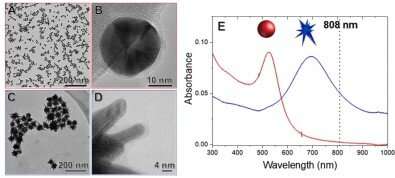Project investigates remote control of enzymes using light

The activity of enzymes in industrial processes, laboratories, and living beings can be remotely controlled using light. This requires their immobilization on the surface of nanoparticles and irradiation with a laser. Near-infrared light can penetrate living tissue without damaging it. The nanoparticles absorb the energy of the radiation and release it back in the form of heat or electronic effects, triggering or intensifying the enzymes' catalytic activity. This configures a new field of study known as plasmonic biocatalysis.
Research conducted at the University of São Paulo's Chemistry Institute (IQ-USP) in Brazil investigated the activity of enzymes immobilized on gold nanoparticles controlled by infrared laser irradiation. An article reporting the results is published in ACS Catalysis, a journal of the American Chemical Society.
The study was supported by São Paulo Research Foundation—FAPESP via a postdoctoral fellowship and a scholarship for a research internship abroad awarded to the lead author, Heloise Ribeiro de Barros; a multiuser equipment grant; and the Thematic Project "Optimization of the physicochemical properties of nanostructured materials for applications in molecular recognition, catalysis and energy conversion/storage", led by Roberto Manuel Torresi.
"We used a lipase [CaLB] as the model enzyme, immobilized on gold nanoparticles with two shapes—spheres and stars," Ribeiro de Barros told. "The infrared laser accelerated the enzyme's activity non-invasively merely by irradiating it with external light."
The study showed that not only the composition of the material but also its geometry influenced the effect of the nanoparticles on the enzyme. "The enzymatic activity was significantly enhanced when the lipase was immobilized on gold nanostars, displaying an increase of up to 58%," Ribeiro de Barros said. "In comparison, the gold nanospheres promoted a much smaller increase of 13%. The larger increase corresponded to the effect of resonance between the surfaces of the nanostars and radiation from the laser."
The magnitude considered here is localized surface plasmon resonance (LSPR). While the LSPR of the nanospheres absorbs at 525 nanometers, that of the nanostars reaches 700 nm, much closer to the infrared laser wavelength, which is 808 nm.
"The incident light sets off energy-driven processes in the gold nanoparticles, such as a rise in temperature or electronic effects, and this affects the properties of the enzymes that are immobilized on their surfaces," Ribeiro de Barros said. "It was possible to conclude that localized photothermal heating on the surfaces of the gold nanostars promoted by LSPR excitation led to enhanced lipase biocatalysis. This conclusion can be extended to other combinations of enzymes and plasmonic nanoparticles."
The wide array of potential applications includes biocatalysis to accelerate industrial-scale chemical reactions and in vivo control of disease-causing enzymes. In the more distant future, this kind of process could conceivably be used to treat diseases such as Parkinson's and Alzheimer's. More research will be required before it can become a genuine alternative, of course.
"From the medical standpoint, the main purpose of the study was to point to solutions in the near future for the treatment of diseases without the need for invasive surgery and with a specific spatial and temporal approach to avoid the side-effects of current methods," Ribeiro de Barros said.
More information: Heloise Ribeiro de Barros et al, Mechanistic Insights into the Light-Driven Catalysis of an Immobilized Lipase on Plasmonic Nanomaterials, ACS Catalysis (2020). DOI: 10.1021/acscatal.0c04919
Journal information: ACS Catalysis
Provided by FAPESP




















